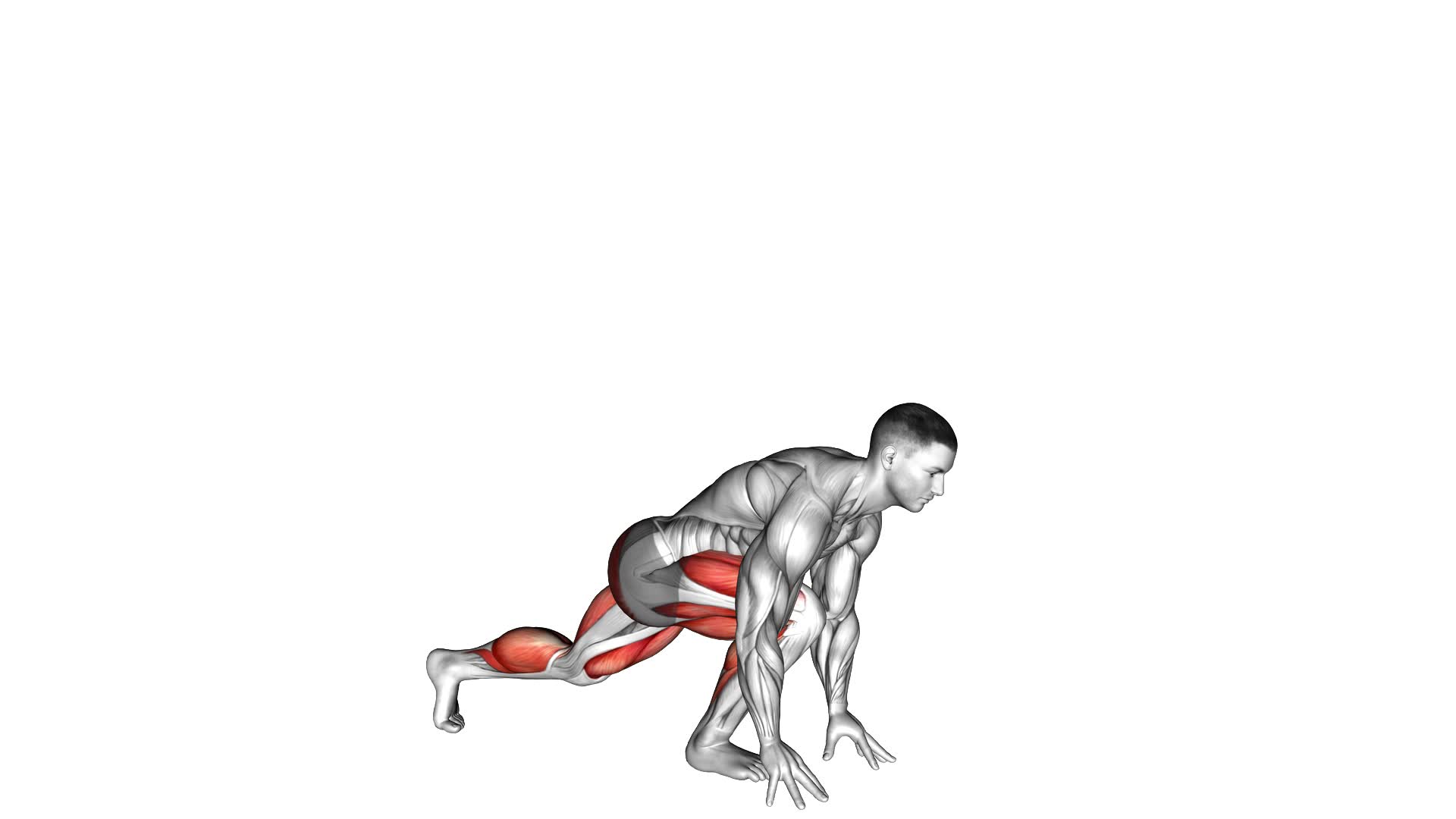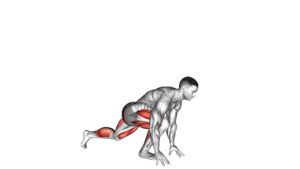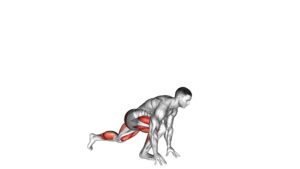Alternate Sprinter Lunge – Video Exercise Guide & Tips

Are you looking for a dynamic exercise that targets multiple muscle groups? Look no further than the alternate sprinter lunge.
Watch This Exercise Video
This video exercise guide and tips will show you how to perform the move with proper form and technique, while avoiding common mistakes.
Whether you're a beginner or advanced, there are modifications for every fitness level.
Plus, we'll share tips on how to increase the intensity for a more challenging workout.
Get ready to lunge your way to stronger legs and a fitter body!
Key Takeaways
- Alternate Sprinter Lunges target multiple lower body muscles including quads, glutes, and hamstrings.
- Incorporating Alternate Sprinter Lunges adds variety to a workout routine and engages different muscle groups than squats.
- The exercise can be modified for every fitness level and helps improve balance, coordination, and stability.
- Advanced progressions such as weighted lunges and plyometric lunges can be incorporated to challenge muscles and improve athleticism.
Benefits of the Alternate Sprinter Lunge
One of the benefits of the Alternate Sprinter Lunge is that it helps improve your lower body strength and stability. When comparing lunges vs squats, lunges specifically target your quads, glutes, and hamstrings, whereas squats primarily work your quads and glutes. Incorporating lunges into your workout routine can add variety and target different muscle groups.
To incorporate lunges into your workout routine, start by standing with your feet hip-width apart. Take a step forward with one foot and lower your body until both knees are at 90-degree angles. Make sure your front knee is directly above your ankle and your back knee is hovering just above the ground. Push off with your front foot to return to the starting position, then repeat on the other side. To add intensity, you can hold dumbbells or a barbell while performing lunges.
Including Alternate Sprinter Lunges in your routine can also help improve your balance and coordination. By engaging your core muscles and maintaining an upright posture, you're training your body to stabilize and control movement. Additionally, the explosive nature of the lunge mimics the movement patterns used during sprinting, making it a great exercise for athletes looking to enhance their speed and power.
Proper Form and Technique
To perform the Alternate Sprinter Lunge with proper form and technique, there are a few key points to keep in mind.
First, make sure to maintain a tall posture throughout the movement, engaging your core and keeping your chest lifted.
Secondly, be mindful of your knee alignment, making sure that your front knee stays directly above your ankle and doesn't collapse inward.
Finally, avoid lunging too far forward, as this can put excessive strain on your front knee.
Essential Lunge Form
To achieve proper form and technique for lunges, you should focus on maintaining a stable and balanced position throughout the exercise. Here are some essential tips to help you achieve the correct lunge form:
- Start with your feet hip-width apart and step forward with one foot, keeping your core engaged.
- Bend both knees to lower your body towards the ground, ensuring that your front knee stays directly above your ankle.
- Keep your back straight and avoid leaning forward or backward.
- Push through your front heel as you return to the starting position.
By following these tips, you can maximize the benefits of lunges, such as improving lower body strength, stability, and flexibility.
Now, let's explore some common technique mistakes to avoid in order to perform lunges effectively.
Common Technique Mistakes
To avoid common technique mistakes and maintain proper form and technique for lunges, focus on the following key points.
- First, make sure to keep your upper body upright and engage your core throughout the movement. This will help you maintain balance and stability.
- Secondly, be mindful of your knee alignment. Your front knee should be directly above your ankle, not extending past it. Also, avoid leaning forward or backward as this can put unnecessary strain on your joints.
- Additionally, take care to step forward with a long enough stride to ensure a proper lunge position.
- Finally, keep your back knee off the ground and your weight evenly distributed between both legs.
By following these tips for improving form, you can enhance the effectiveness of your lunges and reduce the risk of injury.
Now, let's move on to the next section where we'll discuss common mistakes to avoid.
Common Mistakes to Avoid
Avoiding these common mistakes will help you perform the Alternate Sprinter Lunge exercise correctly. Here are some tips for improving your form and avoiding common technique errors:
- Not maintaining proper alignment: Make sure your front knee is directly above your ankle and your back knee is hovering just above the ground. Keep your chest up and your core engaged to prevent any unnecessary strain on your lower back.
- Rushing through the movement: Take your time and focus on each step of the exercise. This will help you engage the correct muscles and get the most out of the movement. Avoid rushing through the lunge and instead, focus on maintaining control and stability.
- Neglecting to engage your glutes: The glutes are an essential muscle group for this exercise. Be sure to squeeze your glutes as you push through your front heel to return to the starting position. This will help activate your glutes and improve your overall performance.
- Forgetting to breathe: Breathing is often overlooked during exercise, but it's crucial for proper form and performance. Remember to inhale as you lower into the lunge and exhale as you push back up. This will help you maintain control, prevent dizziness, and optimize your workout.
Modifications for Different Fitness Levels
Now let's talk about modifications for different fitness levels to ensure that everyone can benefit from the Alternate Sprinter Lunge.
If you're a beginner, you can start by performing the exercise without weights or by using a chair for support.
For intermediate levels, try adding dumbbells or increasing the range of motion.
Advanced individuals can challenge themselves by incorporating jumps or incorporating a medicine ball into the exercise.
Beginner Modifications
Start with one set of five alternating sprinter lunges, focusing on proper form and control.
As a beginner, it's important to modify the exercise to suit your fitness level. Here are some beginner modifications and variations to help you get started:
- Reduce the range of motion: If you find it challenging to lunge deeply, start by taking smaller steps and focusing on maintaining balance and stability.
- Use a support: If you struggle with balance, hold onto a chair or wall for support while performing the lunges.
- Slow down the movement: Instead of performing the lunges at a fast pace, slow down and focus on control. This will help you develop proper form and prevent injury.
- Decrease the number of repetitions: Start with fewer repetitions, such as three or four, and gradually increase as you become more comfortable and stronger.
Intermediate Adaptations
To progress your workout and accommodate different fitness levels, incorporate these intermediate adaptations to the alternate sprinter lunge exercise.
For advanced modifications, you can add weight by holding dumbbells or using a weighted vest. This will intensify the exercise and challenge your muscles even more.
Another option is to increase the speed and explosiveness of the movement, turning it into a plyometric exercise. This will improve your power and athleticism.
In terms of muscle groups targeted, the alternate sprinter lunge primarily works the quadriceps, hamstrings, glutes, and calves. However, by adding a twist at the torso during the lunge, you can engage your obliques and core muscles as well.
Remember to always maintain proper form and listen to your body to avoid injury.
Advanced Progressions
To further challenge yourself and continue progressing your workout with the alternate sprinter lunge, incorporate advanced modifications based on your fitness level.
Here are four advanced lunge variations to try:
- Weighted Lunge: Hold dumbbells or kettlebells in each hand while performing the alternate sprinter lunge. This added resistance will increase the intensity and engage your muscles even more.
- Plyometric Lunge: Add an explosive jump into the lunge movement. This will elevate your heart rate, improve power, and enhance overall athletic performance.
- Reverse Lunge with Rotation: Instead of stepping forward, step backward into a lunge and rotate your torso towards the front leg. This variation targets your core muscles and improves rotational stability.
- Bulgarian Split Squat: Elevate your back foot on a bench or step, and perform the lunge movement in a split stance. This variation places more emphasis on your glutes and hamstrings.
Incorporating these advanced modifications will take your alternate sprinter lunge to the next level, challenging your muscles and helping you achieve your fitness goals.
Tips for Increasing Intensity
Increase the intensity of your alternate sprinter lunges with these tips. To further challenge yourself and maximize the benefits of this exercise, consider increasing the difficulty level.
One way to do this is by incorporating weights. Hold dumbbells or kettlebells in each hand while performing the lunges. This added resistance will engage your muscles even more and elevate the intensity of the exercise.
Another variation for advanced users is to perform explosive or plyometric lunges. Instead of simply stepping forward and back, explosively switch legs in mid-air, as if you were performing a jumping lunge. This dynamic movement won't only increase the difficulty but also enhance your power and explosiveness.
To further intensify your alternate sprinter lunges, try increasing the speed at which you perform them. By moving faster, you'll engage your muscles more intensely and increase your cardiovascular endurance. However, make sure to maintain proper form and control throughout the exercise.
Lastly, consider incorporating interval training into your alternate sprinter lunges. Alternate between periods of high-intensity lunges and periods of rest or low-intensity lunges. This will challenge your body and help you improve your overall fitness level.
Sample Workout Routine Using Alternate Sprinter Lunges
To maximize the benefits of your alternate sprinter lunges, incorporate them into your workout routine consistently and challenge yourself with different variations and intensities.
Here is a sample workout routine that includes alternate sprinter lunges, along with some modifications and tips for proper form:
- Warm-up: Start with a 5-minute cardio warm-up, such as jogging or jumping jacks, to get your blood flowing and prepare your muscles for the workout.
- Alternate Sprinter Lunges: Perform 3 sets of 10-12 reps on each leg. Keep your back straight, chest up, and core engaged throughout the exercise. Take a big step forward with your right leg, lowering your body into a lunge position. Push off your right foot and bring your left leg forward into a lunge position on the other side. Repeat for the desired number of reps.
- Modification: If you're a beginner or have knee issues, you can modify the exercise by reducing the depth of the lunge or using a shorter range of motion.
- Cool-down: Finish the workout with a 5-minute cool-down, such as stretching or light walking, to help your muscles recover and prevent post-workout soreness.
Remember to listen to your body and adjust the intensity of the workout as needed. Proper form is crucial for avoiding injuries, so focus on maintaining good posture and engaging the correct muscles throughout the exercise.
Frequently Asked Questions
How Many Calories Can You Burn by Doing Alternate Sprinter Lunges?
Incorporating alternate sprinter lunges into your workout routine can have numerous benefits.
Not only does it target your leg muscles, but it also engages your core and improves your balance.
When performed properly, alternate sprinter lunges can help you burn a significant amount of calories.
To maximize calorie burn, focus on maintaining proper form and increasing your intensity.
Keep pushing yourself and you'll see the results in no time.
Can Alternate Sprinter Lunges Help Improve Flexibility?
Alternate sprinter lunges can indeed help improve flexibility. By incorporating these lunges into your dynamic warm-up routine, you can gradually increase the range of motion in your hip flexors, quadriceps, and hamstrings. This exercise targets these muscle groups and promotes better flexibility over time.
If you're a beginner or have limited flexibility, you can modify the alternate sprinter lunge by taking smaller steps and reducing the depth of the lunge. Remember to listen to your body and never push past your comfort level.
Are There Any Specific Muscles That Are Targeted by Alternate Sprinter Lunges?
Alternate sprinter lunges target several specific muscles in the lower body. They work your quadriceps, hamstrings, glutes, and calves. By engaging these muscle groups, alternate sprinter lunges help improve lower body strength.
To perform them properly, start by standing with one foot forward and the other foot back. Then, lunge forward, bending both knees and keeping your back straight. Push off with your front foot to return to the starting position. Repeat on the other side.
Can Alternate Sprinter Lunges Be Incorporated Into a Cardio Workout?
Incorporating alternate sprinter lunges into a cardio workout can be a great way to increase intensity and target different muscle groups. They add variety and challenge to your routine, helping to elevate your heart rate and burn more calories.
Are There Any Potential Risks or Injuries Associated With Doing Alternate Sprinter Lunges?
When it comes to alternate sprinter lunges, it's important to be aware of any potential risks or common injuries. These exercises can put strain on your knees and ankles if not performed with proper form and alignment.
It's crucial to warm up properly and listen to your body. If you experience any pain or discomfort, it's best to stop and consult a professional.
Conclusion
To conclude, the alternate sprinter lunge is a highly beneficial exercise that targets multiple muscle groups and improves lower body strength, balance, and coordination.
By maintaining proper form and avoiding common mistakes, you can maximize the effectiveness of this exercise.
Additionally, modifications and tips for increasing intensity allow individuals of all fitness levels to incorporate alternate sprinter lunges into their workout routine.
So, add this dynamic exercise to your fitness regimen and enjoy the benefits it offers.

Author
Years ago, the spark of my life’s passion ignited in my mind the moment I stepped into the local gym for the first time. The inaugural bead of perspiration, the initial endeavor, the very first surge of endorphins, and a sense of pride that washed over me post-workout marked the beginning of my deep-seated interest in strength sports, fitness, and sports nutrition. This very curiosity blossomed rapidly into a profound fascination, propelling me to earn a Master’s degree in Physical Education from the Academy of Physical Education in Krakow, followed by a Sports Manager diploma from the Jagiellonian University. My journey of growth led me to gain more specialized qualifications, such as being a certified personal trainer with a focus on sports dietetics, a lifeguard, and an instructor for wellness and corrective gymnastics. Theoretical knowledge paired seamlessly with practical experience, reinforcing my belief that the transformation of individuals under my guidance was also a reflection of my personal growth. This belief holds true even today. Each day, I strive to push the boundaries and explore new realms. These realms gently elevate me to greater heights. The unique combination of passion for my field and the continuous quest for growth fuels my drive to break new ground.







